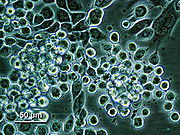
Sf21
Encyclopedia

Sf21 is a continuous cell line developed from ovaries of the Fall Army worm
Army worm
The Fall Armyworm is part of the order of Lepidoptera and is the caterpillar life stage of a moth. It is regarded as a pest and can wreak havoc with crops if left to multiply. Its name is derived from its feeding habits...
, Spodoptera frugiperda, a moth
Moth
A moth is an insect closely related to the butterfly, both being of the order Lepidoptera. Moths form the majority of this order; there are thought to be 150,000 to 250,000 different species of moth , with thousands of species yet to be described...
species that is an agricultural pest on corn and other grass species. It was originally developed in the United States at the Henry A. Wallace Beltsville Agricultural Research Center
Henry A. Wallace Beltsville Agricultural Research Center
The Henry A. Wallace Beltsville Agricultural Research Center, or BARC, is a unit of the United States Department of Agriculture's Agricultural Research Service. It is located at in Beltsville, Maryland, and is named for Henry A. Wallace, former United States vice president and secretary of...
. Sf9 is a substrain (clone
Cloning
Cloning in biology is the process of producing similar populations of genetically identical individuals that occurs in nature when organisms such as bacteria, insects or plants reproduce asexually. Cloning in biotechnology refers to processes used to create copies of DNA fragments , cells , or...
) of these cells that was isolated from Sf21 by researchers at Texas A&M University
Texas A&M University
Texas A&M University is a coeducational public research university located in College Station, Texas . It is the flagship institution of the Texas A&M University System. The sixth-largest university in the United States, A&M's enrollment for Fall 2011 was over 50,000 for the first time in school...
.
Both the clone and parent strains of the cells have been extensively used in research on virus
Virus
A virus is a small infectious agent that can replicate only inside the living cells of organisms. Viruses infect all types of organisms, from animals and plants to bacteria and archaea...
es, especially baculovirus
Baculovirus
The baculoviruses are a family of large rod-shaped viruses that can be divided to two genera: nucleopolyhedroviruses and granuloviruses . While GVs contain only one nucleocapsid per envelope, NPVs contain either single or multiple nucleocapsids per envelope. The enveloped virions are further...
es in their use for producing recombinant proteins.
This is just one of the over 500 insect cell lines that have been developed from more than 125 insect species
Species
In biology, a species is one of the basic units of biological classification and a taxonomic rank. A species is often defined as a group of organisms capable of interbreeding and producing fertile offspring. While in many cases this definition is adequate, more precise or differing measures are...
.

